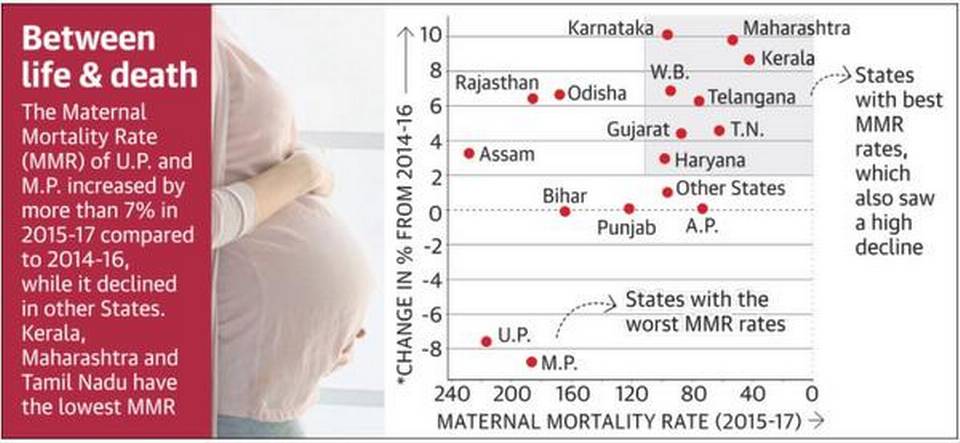Special bulletin on India’s maternal mortality ratio (MMR) 11/11/2019 – Posted in: Daily News – Tags: Kilkari project, Mother and Child Tracking System, Registrar General of India
India’s maternal mortality ratio
For: Preliminary & Mains
Topics covered:
- Key findings of India’s maternal mortality ratio
- About Surakshit Matritva Aashwasan
- About Registrar General and Census Commissioner of India
News Flash
India’s maternal mortality rate declined by 8 points (6.2% decline) in one year from 130 per lakh live births in 2014-16 to 122 per lakh live births in 2015-17 as per the latest bulletin on MMR released by the Registrar General of India.
This decline is important as it translates to nearly 2,000 additional pregnant women saved annually. Also, the decline means that India is on track to achieve the Sustainable Development Goal target for reducing MMR by 2025, five years ahead of the timeline of 2030.

India’s Maternal Mortality Ratio
Key points
- Eleven states have already achieved the ambitious target of MMR of 100 per lakh live births by 2020 set under the National Health Policy 2017.
- These states are Kerala, Maharashtra, Tamil Nadu, Andhra Pradesh, Jharkhand, Telangana, Gujarat, Uttarakhand, West Bengal, Karnataka and Haryana.
- Seven states — Karnataka, Maharashtra, Kerala, West Bengal, Odisha, Rajasthan, Telangana — have shown a decline in MMR that is greater than or equal to the national average of 6.2%.
- Karnataka is the only state in the country that has seen more than a 10% decline in MMR.
- Kerala tops the list with the lowest MMR at 42 per lakh live births, Assam has the highest at 229 per lakh live births.
- Uttar Pradesh and Madhya Pradesh have shown an increase by 15 points each in MMR.
- Independent MMR data of Jharkhand (76), Chhattisgarh (141) and Uttarakhand (89) has been released for the first time in the SRS 2015-2017 bulletin.
- Rajasthan’s MMR has shown the highest decrease by 13 points.
Categorization of states
To understand the maternal mortality situation in the country better and to map the changes, especially at the regional level, the government has categorised states into three groups:
- Empowered action group (EAG): Bihar, Jharkhand, Madhya Pradesh, Chhattisgarh, Odisha, Rajasthan, Uttar Pradesh/Uttarakhand and Assam fall under the EAG.
- Southern States: Andhra Pradesh, Telangana, Karnataka, Kerala and Tamil Nadu are in the southern States group.
- Other states: “Others” comprise the remaining States and Union Territories.
Strength of the health system
The maternal mortality rate is recognised the world over as one of the health parameters that show the robustness of a health system. The commonest causes of maternal mortality are infections, eclampsia and post-partum hemorrhage.
Surakshit Matritva Aashwasan
- India recently launched the ‘Surakshit Matritva Aashwasan’ (SUMAN) programme for zero preventable maternal and newborn deaths.
- These include Mother and Child Tracking System, through which expecting mothers and health workers are tracked and informed about vaccinations and health checks, and the Kilkari project, a mobile voice message service that delivers weekly messages to families about pregnancy, family planning, nutrition, childbirth and maternal and child care.
Registrar General and Census Commissioner of India
- RGCCI was founded in 1961 for arranging, conducting and analysing the results of the demographic surveys of India including the Census of India and Linguistic Survey of India.
- The position of Registrar is usually held by a civil servant holding the rank of Joint Secretary.
Source: Indian Express
READ MORE DAILY NEWS
- National Programme for Organic Production (NPOP)
- Study “Climate Change and Heat-Induced Mortality in India”
- ‘India Internet 2019’ Report
- South Asia Co-operative Environment Programme (SACEP)
- Alternative Investment Fund
- Indian Air quality Interactive Repository (IndAIR)
- Vaccine Hesitancy
- Danakil Depression
You are on the Best Online IAS preparation platform. You are learning under experts.
We are present on Facebook- Diligent IAS, LinkedIn- Diligent IAS, YouTube- Diligent IAS, Instagram- Diligent IAS. Get in touch with us.
